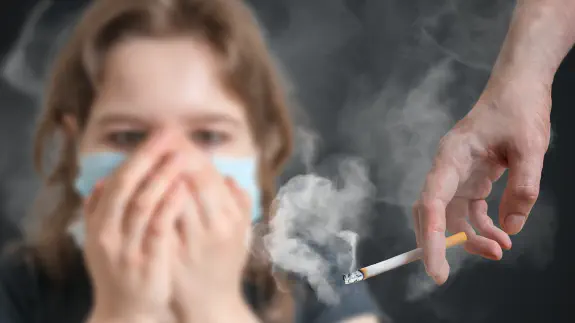Sex and Gender-based Analysis of this topic
Definition
Environmental tobacco smoke, or second-hand smoke (SHS), is defined as the smoke exhaled by a smoker or the smoke released by the end of a burning cigarette, pipe, or cigar [1]. SHS contains over 4,000 chemicals, 50 of which are known carcinogens [2]. SHS is extremely damaging to the health of those that inhale it, raising their risk of heart problems, lung cancer, and respiratory disease [1]. Exposure for as little as 8-20 minutes can be potentially harmful [3]. In 2003, 33% of Canadian non-smokers reported that they are regularly exposed to SHS [4]. The most common setting for SHS exposure is public places (20%), followed by home and work (11%), and in private vehicles (10%) [4].
Sex Issues
Although research into sex-differentiated effects is still in its early stages, evidence is emerging that women are more susceptible to the negative health impacts of exposure to SHS than men, including higher risks for cardiovascular disease [5]. A panel of experts conducted an evidence review and determined that exposure to SHS alone significantly increases a woman’s risk for developing breast cancer [6]. As women are at a higher risk of negative health effects from smoking than men, there is reason to suspect that more sex-related risks to SHS exposure will be discovered. For women, smoking the same amount as a man will lead to higher rates of breast cancer [6], impaired lung function, respiratory tract symptoms, addiction to nicotine, and lung cancer [7]. Strikingly, for similar amounts of smoking, women are twice as likely to develop lung cancer as men are [8-10]. Strong evidence suggests that both active smoking and SHS exposure increases the risk of breast cancer for women [11].
Gender Issues
Although exposure to SHS has been shown to have severely negative health impacts, many women continue to be exposed. Gendered social roles may shape this risk of exposure. For example, women may not feel they have adequate power in their relationship to insist that their partner not smoke in the house or car. A study across 31 countries found that the air in households with smokers contained 17 times more nicotine than the air in non-smoking households [12], indicating that having one smoker in a family typically means significant SHS exposure for all other family members. Additionally, service-industry jobs are predominantly held by women and up until recently when smoking was banned in restaurants, this represented a significant gender-related exposure risk [5, 13].
Diversity
Exposure to SHS varies greatly across the Canadian provinces, generally mirroring the rates of smoking for each province. British Columbia and Ontario have the lowest levels of exposure to SHS as well as the lowest smoking rates, while Quebec has the highest levels of exposure to SHS and the highest smoking rates [4]. The provinces also vary in the setting of exposure. For example, compared to national averages, Alberta has a high rate of exposure at the workplace, but a low level of exposure in the home.
Because of the correlation between high smoking rates and high levels of exposure to SHS, risks for Canadian subpopulations with high smoking rates may have correspondingly high levels of exposure to SHS. Those groups include Aboriginal people [14], youth [4], low socioeconomic groups, individuals with mental illness [15], and non-white minorities [6].
Critique
The health impacts of exposure to second-hand smoke are only now being discovered and more are likely to be identified over the next few years. Although surveys give general exposure data, it is critical to conduct longitudinal and qualitative studies to understand the complex relationship between SHS exposure, gender, and health. Evidence has also pointed to higher risks from SHS for specific populations of women who are either at risk due to their social context or genetic susceptibility. Additionally, studies are necessary to determine which risk factors contribute the most to SHS exposure and should therefore be the target of preventative measures.
